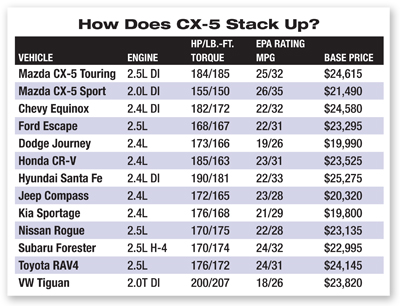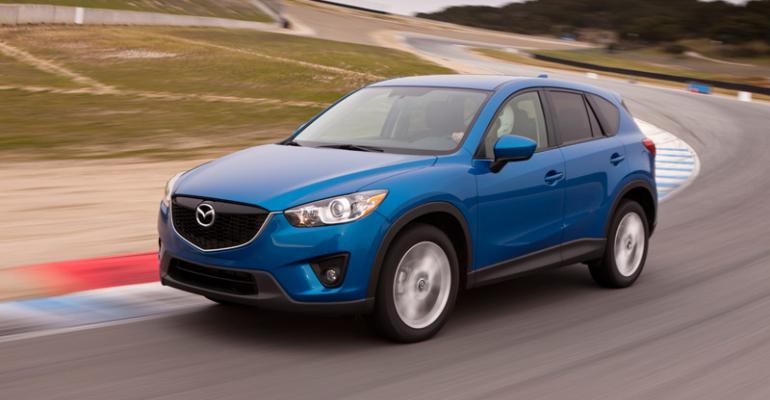AUSTIN, TX – The ’13 Mazda CX-5 compact cross/utility vehicle had many fine attributes when it launched in the U.S. one year ago: great handling, sharp looks, a comfortable interior and competitive pricing.
The weak link was under the hood.
The 155-hp 2.0L Skyactiv DOHC 4-cyl. was and is a benchmark powerplant in the compact Mazda3, winning a 2012 Ward’s 10 Best Engines trophy. But it is less stout in the CX-5, which is 322 lbs. (146 kg) heavier and lacks the aerodynamic slipperiness of the small sedan.
Help is a half-liter away.
Now on sale, the ’14 CX-5 Touring and Grand Touring is available with a 184-hp 2.5L gasoline direct-injection 4-cyl. that represents the second engine hailing from Mazda’s so-called Skyactiv fuel-efficient-yet-fun product philosophy.
The more powerful 2.5L 4-cyl. borrows some of the best features of the 2.0L Skyactiv and coincidentally shares the identical bore-and-stroke dimensions as Mazda’s outgoing MZR-series 2.5L port-injection I-4, which was rated at 170 hp and 167 lb.-ft. (226 Nm) of torque in the ’13 Mazda6 sedan, being replaced by the all-new ’14 model rolling out now.
In the U.S., both the 2.0L and 2.5L engines are offered in the CX-5 with front- or all-wheel drive, and Mazda expects an even distribution between the two.
The Skyactiv engines share all-aluminum construction; direct fuel injection; 87-octane compatibility; 13.0:1 compression ratio and a DOHC architecture with four valves per cylinder and variable valve timing on both intake and exhaust ports.
 But beyond a handful of shared parts, the two Skyactiv powerplants are unique and require bespoke heads, blocks, connecting rods, bearings and other components. Bore and stroke dimensions are different as well.
But beyond a handful of shared parts, the two Skyactiv powerplants are unique and require bespoke heads, blocks, connecting rods, bearings and other components. Bore and stroke dimensions are different as well.
The redesigned pistons, for instance, incorporate a “volcano” top to form a pocket for the business end of the spark plug to enable more complete combustion.
Despite the two Skyactiv engines being so different, Mazda engineered them to be machined and manufactured on the same assembly line in Hiroshima, Japan, a first for the auto maker and a smart play economically. Production of the 2.5L began in October.
Even V-6 engines and diesels – a new oil burner arrives later this year – can share the same line. As for a new rotary engine, Mazda says a dedicated assembly line most likely would be necessary.
On the road here deep in the heart of Texas, the new 2.5L propels the CX-5 with ease, pulling it uphill effortlessly, cruising comfortably at steady-state on the highway and delivering sporty zip uncommon in this high-volume (and growing) sector of cute-utes.
In the off chance that a wide-open throttle run becomes necessary, the Skyactiv I-4 can handle the request efficiently and with reduced emissions, thanks to a “kick-down” switch that is standard with the 2.5L in both the CX-5 and new Mazda6.
With the accelerator to the floor, most drivers will find all the power they need.
But wait, there’s more. Push the right toe a few more degrees and the kick-down switch can be bypassed, forcing the 6-speed automatic transmission to drop a gear (or two), triggering a primal howl that spins the wheels even faster and comes on like a performance-enhancing drug. Only, this one is legal.
Fuel economy is better with the 2.0L Skyactiv, and for that reason it will remain in the CX-5 Sport, which also comes with a capable 6-speed manual transmission. The 2.5L engine only will be paired with the 6-speed auto, although it is available with the manual in the new Mazda6.
But the 2.5L is no slouch when it comes to fuel economy. Our test drive on mostly rural roads and highways yields a commendable average of 28 mpg (8.4 L/100 km) with a loaded AWD model.
The Environmental Protection Agency rates the 2.5L CX-5 with AWD at 24/30 mpg (9.8-7.8 L/100 km) city/highway and 25/32 mpg (9.4-7.3 L/100 km) with FWD. With an automatic transmission and FWD, the CX-5 is rated at 32 mpg (7.3 L/100 km) on the highway with either engine.
The fuel-economy ratings, as well as stout horsepower and torque, place the 2.5L CX-5 among the segment’s leaders.
With both the 2.0L and 2.5L in the mix, the auto maker expects 30% of buyers to pick the 2.0L and the remaining 70% to opt for the bigger engine, split between 45% Touring and 25% Grand Touring.
Of course, Mazda is launching a new 2.2L turbodiesel in the Mazda6 later this year. If that engine proves popular, the auto maker will consider putting it in the CX-5. In Japan, about 80% of CX-5 buyers are picking the diesel, outpacing sales projections in the region by a factor of five.
The 2.5L adds more than 100 lbs. (45 kg) to the CX-5, which now weighs in at 3,375 lbs. (1,531 kg) driven by the front wheels and 3,532 lbs. (1,602 kg) with AWD.
Pricing for the ’14 CX-5 starts at $21,195 with the 2.0L Skyactiv and 6-speed manual and tops out at $28,870 with the 2.5L in Grand Touring dress. Tack on another $795 for destination charges.
The most expensive option is the $1,625 Grand Touring technology package, which includes navigation, bi-xenon headlamps, advanced keyless entry, auto-dimming mirror and Smart City automated emergency brake support.
Did Mazda miscalculate by launching the CX-5 without the 2.5L? A Mazda executive says the plan all along was to add the engine to the mix later and insists folding in the 2.5L one year after launch was not a kneejerk reaction to criticism the 2.0L couldn’t provide enough Zoom-Zoom.
What matters is that even without the 2.5L, the CX-5 has been an unqualified hit, requiring the auto maker to boost production in Hofu, Japan, three times to meet burgeoning demand. U.S. sales of the CX-5 totaled 43,319 units in 2012, making it far and away Mazda’s best-selling CUV, according to WardsAuto data.
The addition of a more powerful 4-cyl. surely will send volumes even higher and could force the auto maker to consider yet another production increase.
| Vehicle type | Five-passenger FWD CUV |
| Engine | 2.5L Skyactiv DOHC GDI all-aluminum 4-cyl. |
| Power (SAE net) | 184 hp @ 5,700 rpm |
| Torque | 185 lb.-ft. (251 Nm) @ 3,250 rpm |
| Bore x stroke (mm) | 89 x 100 |
| Compression ratio | 13.0:1 |
| Transmission | 6-speed automatic |
| Curb weight | 3,375 lbs. (1,531 kg) |




